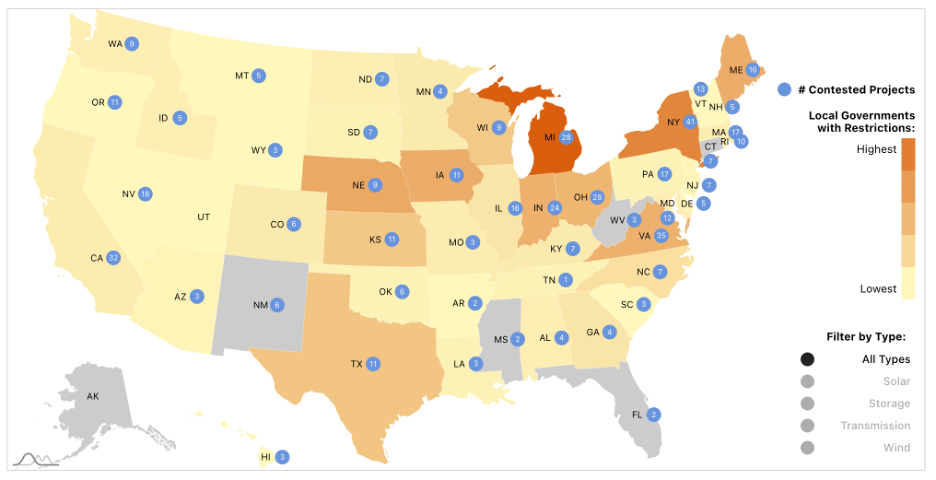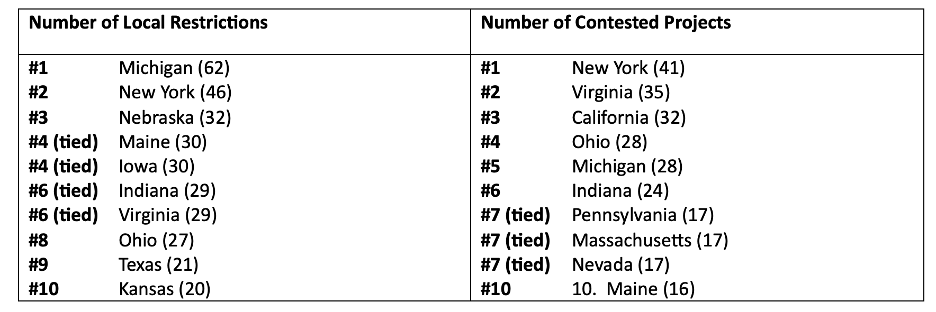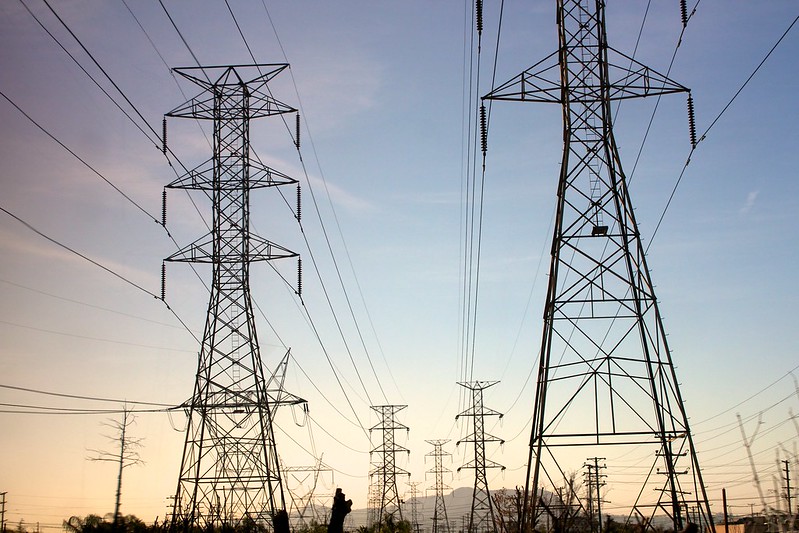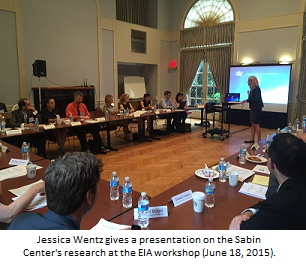While federal policy can have a significant impact on renewable energy development, local policy—and local sentiment—can be just as consequential. Between 2018-2023, at least 30% of utility-scale wind and solar projects were cancelled during the siting process, largely because of community opposition, local ordinances, and zoning. For the last five years, the Sabin Center has been tracking this phenomenon in an annual report, Opposition to Renewable Energy Facilities in the United States, which catalogs contested projects, as well as severe state and local restrictions in each state.
Today, the Sabin Center released a fifth edition of the report, adding developments through the end of December 31, 2024. The report finds that, by the end of 2024, at least 459 counties and municipalities across 44 states had adopted severe local restrictions on siting renewables. This tally represents an increase of 16% in the prevalence of local restrictions in just one year. This 2025 edition further identifies 498 contested projects in 49 states, an increase of 32% over last year’s edition. The report also documents 20 significant state-level restrictions in 16 states. Notably, while the report includes all of the qualifying restrictions and controversies the authors have identified, it does not purport to be exhaustive.
To supplement the PDF version of the report, the Sabin Center has also launched a new website, Opposition Report (oppositionreport.org). The website offers interactive maps and access to the report’s data files. The data files provide information about project type, status, capacity, acreage, litigation history, and other factors.
Figure 1: Screenshot of Interactive Map from Opposition Report Website

The report describes significant developments at the state level in 2024, including:
- the adoption of a new law in Florida that bans offshore wind in state waters and bans onshore wind turbines within 1 mile of the coast;
- the enactment of legislative reforms in Massachusetts and Minnesota to streamline renewable energy siting; and
- litigation challenging the implementation of a Michigan law that gives the Michigan Public Service Commission the authority to preempt certain local restrictions.
At the local level, the report notes that two states, Arkansas and Montana, saw severe local restrictions for the first time, as counties in each state moved to block wind turbines. The report further highlights updates in other states, including Ohio, where 26 out of 88 counties have now established restricted areas where utility-scale wind or solar or both are prohibited. A table from the report showing the states with the highest numbers of local restrictions and highest numbers of contested projects is below.
Figure 2: Top 10 States for Local Restrictions and Contested Projects

Looking at contested projects, the database shows approximately four times more litigation in state court than federal court. However, an extraordinarily high percentage of the country’s nine fully permitted offshore wind projects was subject to federal litigation in 2024, with active federal lawsuits proceeding against five projects: South Fork Wind, Revolution Wind, Vineyard Wind, MarWin, and Coastal Virginia Offshore Wind. In December 2024, Cape May County finally dropped a lawsuit against Ocean Wind 1, which had been canceled for financial reasons in 2023.
While opponents of offshore wind projects have not succeeded in persuading federal courts to stop development, they have found support from other branches of government. Already, the Trump Administration has temporarily ended new leasing for offshore wind and halted federal permitting of onshore and offshore wind. In addition, the Administration has attempted to block the construction of two fully permitted offshore wind projects: first by revoking a permit necessary for the construction of the Atlantic Shores Offshore Wind project off the coast of New Jersey; and second by temporarily imposing a stop-work order on Empire Wind 1 off the coast of New York. These executive actions to block wind energy are being challenged in court by a group of 18 state attorneys general.
The report was prepared as part of the work of the Sabin Center’s Renewable Energy Legal Defense Initiative (RELDI). RELDI conducts independent research on issues related to siting renewable energy infrastructure and facilitates pro bono legal representation to community groups and local residents who support renewable energy projects in their communities that are facing opposition.
Matthew Eisenson is a Senior Fellow at the Sabin Center for Climate Change Law, where he leads the Renewable Energy Legal Defense Initiative (RELDI).




